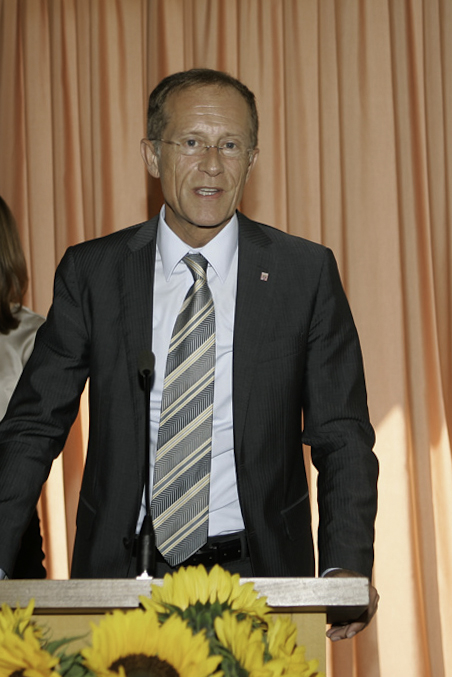
LANGENHAIN, GERMANY — Prominent religious and political figures gathered here at the start of a program of festivities to mark the 50th anniversary of the first Baha'i House of Worship on the European continent.
In the opening reception held at Germany's National Bahá'í Center on 3 July, the Minister of State and head of the Chancellery of the state of Hesse, Mr. Axel Wintermeyer, addressed an audience of some 130 people. In his remarks, he extolled the Bahá'í teachings for promoting "dialogue that is characterized by a respect and tolerance for all religions".
"Many violent conflicts in the world are motivated by religious intolerance," Mr. Wintermeyer said, "and world peace is not possible without religious peace."
"The Baha'i House of Worship, in contrast, is a symbol for religious coexistence and tolerance. Everybody is welcome."
The head of the Round Table of Religions in Germany, Reverend Dr. Franz Brendle, also addressed the audience, expressing his gratitude for the contribution Bahá'ís are making to interreligious dialogue and for their community-building efforts.

"You are characterized by your peaceful attitude towards others," said Dr. Brendle.
Professor Ingo Hofmann, a representative of the Bahá'í community in Germany, explained that worship alone is not sufficient for the establishment of a just and prosperous society.
An integral concept of each Baha'i House of Worship is that it provides a spiritual center around which agencies and institutions of social, humanitarian, and educational service can be established for the surrounding population.
"Work conducted in the spirit of service to humanity is true worship of God," said Professor Hofmann.
The House of Worship was dedicated on 4 July 1964 after three-and-a-half years of construction. It was declared a cultural monument for Hesse in 1987 and is considered a major landmark of the Main-Taunus district.
Highlighting the building's distinctive design, Wolfgang Exner, a town councilor from Hofheim am Taunus, emphasized how proud the people of the region are to have "this jewel of architecture near us".
"We love to bring guests here and proudly show them our Baha'i temple," he said.
Also present in the audience was Teuto Rocholl, the architect of the Temple. Mr. Rocholl attended the reception with his wife and daughter as the guests of honor.
Following the reception, those present attended a special devotional program in the Baha'i House of Worship.
The 50th anniversary festivities continued on Sunday 6 July when the German Baha'i community hosted an annual Sommerfest on the grounds of the Temple. Some 3,000 visitors came from the surrounding neighborhoods as well as further afield. A cultural program included interactive theater and musical performances from The Mood, a local youth choir from Langenhain. Four devotional programs took place within the House of Worship during the day.
An art exhibition marking the anniversary is also being held throughout the month of July, showing paintings and photography inspired by the House of Worship by 12 artists from Langenhain and the surrounding region.